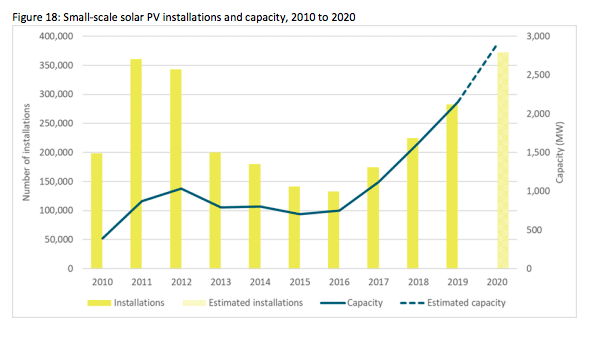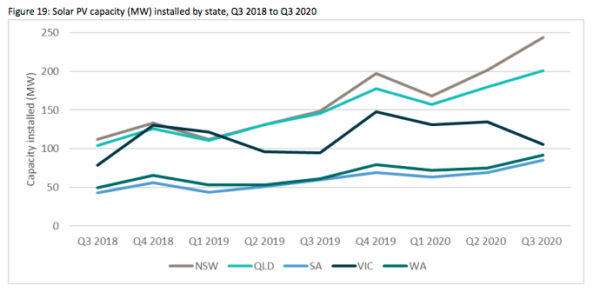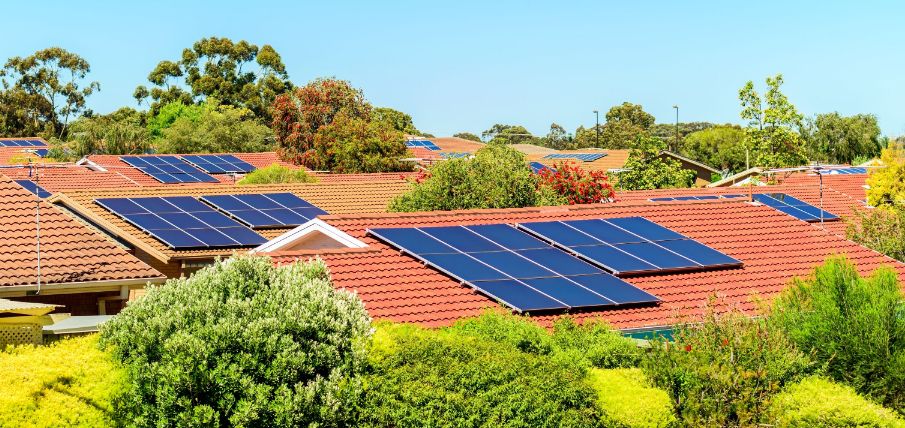On track to set a new record, small scale rooftop solar PV is expected to install 2.9 GW this year, up 34% from the previous record of 2.2 GW installed in 2019, CER’s Chair David Parker found.
Despite Covid-19 lockdowns causing the rate of solar installations in Victoria to fall by 40%, increases New South Wales, South Australia and Western Australia countered the decline. “A remarkable 750 megawatts (MW) was installed in Quarter 3 2020, 42% more than Quarter 3 2019,” Parker said.
Demand for rooftop solar is expected to remain strong in the future too, according to the regulator. It commissioned modelling that suggests an average of 3.2 GW could be added each year for the next four years. “If realised, this investment would effectively double rooftop solar capacity, to 26 GW, by the end of 2024.” This, Parker says, would “dramatically change” the energy landscape in Australia, with small and mid-scale sectors set to outstrip the capacity of the large-scale sector.
According to the commissioned modelling, “about 75% of all solar capacity in 2020 is expected to come from small and mid-scale sectors, with only 919 MW of installations anticipated in the large-scale sector,” Parker said.

Clean Energy Regulator
“Investment in small (0 -100 kW) and mid-scale (100 kW to 30 MW) solar PV has continued to grow, with more than 3 GW capacity expected to be installed in 2020. This is four times the additional capacity installed in 2016.”
The report also pointed out small and mid-scale installations of solar PV forecasts have dramatically and consistently underestimated demand for rooftop and small grid connected solar. “This underestimation has real consequences, as it has resulted in grid-stability issues, price and revenue implications and under investment in grid infrastructure. Modelling to date has not provided the early warning needed to plan and prepare for a highly distributed energy future,” Parker said.
The report also noted abundant rooftop solar generation in some regions occasionally dampened the demand for large-scale generation, including from renewables.
Yet even this amassment of setbacks hasn’t dampened growth in large-scale investments, which the report found has remained strong. In fact, there has been more investment in large-scale renewables in the first nine months of 2020, at 2.5 GW, than in the whole of 2019, which was 2.3 GW. The growth, the report noted, is particularly noteworthy in a year overshadowed by a global pandemic. The regulator’s report went on to say it is possible Australia may exceed its forecast, which was between 2 GW to 3 GW, by the end of the year.
“The Clean Energy Regulator estimates the 2020 target of 33 TWh of large-scale generation is likely to be met and, notwithstanding a number of constraints, set another record compared to 2019 generation of just over 28 TWh.”
“Very large staged renewable energy projects are now a clear feature of the investment environment, with first phase approvals for three projects exceeding 500 MW capacity. It is likely some of these very large projects may need grid constraints to be resolved and/or Renewable Energy Zones (REZs) to come online if they are to be built to their full capacity,” Parker said in the report.
On Tuesday, Victoria’s state government announced it is committing $540 million to developing such zones, as well as kickstarting the construction of new transmission lines in the plagued West Murray Zone, which has come as welcome news to many.

Clean Energy Regulator
Minister for Energy and Emissions Reduction Angus Taylor was quick to jump on the report’s findings, saying that it proved Labor Party claims that investment in renewables has collapsed under the Coalition weren’t supported.
“Australian families and businesses are adopting new energy technologies like rooftop solar at record-breaking rates, and we expect this trend will continue for the foreseeable future… that is why initiatives like the $1 billion Grid Reliability Fund are so important,” Taylor said in a statement.
In Australia, renewable energy is growing at a per capita rate ten times faster than the global average, with the share of renewable energy in Australia’s electricity generation expected to reach around 30 per cent by the end of 2020.
This content is protected by copyright and may not be reused. If you want to cooperate with us and would like to reuse some of our content, please contact: editors@pv-magazine.com.









By submitting this form you agree to pv magazine using your data for the purposes of publishing your comment.
Your personal data will only be disclosed or otherwise transmitted to third parties for the purposes of spam filtering or if this is necessary for technical maintenance of the website. Any other transfer to third parties will not take place unless this is justified on the basis of applicable data protection regulations or if pv magazine is legally obliged to do so.
You may revoke this consent at any time with effect for the future, in which case your personal data will be deleted immediately. Otherwise, your data will be deleted if pv magazine has processed your request or the purpose of data storage is fulfilled.
Further information on data privacy can be found in our Data Protection Policy.